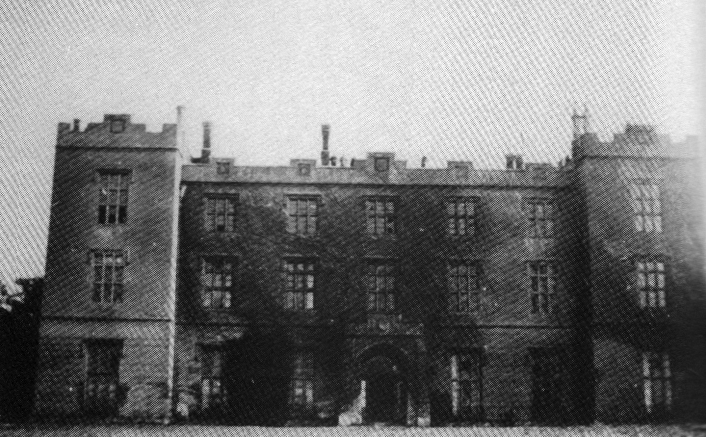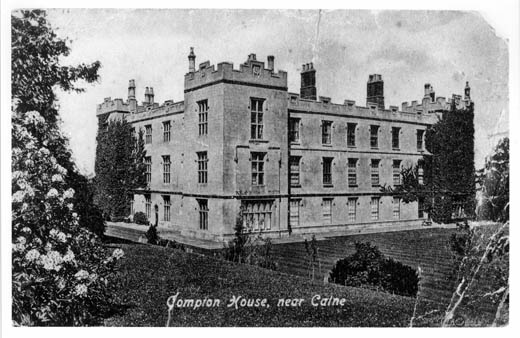


Compton Bassett House, taken just before its demolition.
Compton Bassett village lies c. 3.5 km. ENE. of Calne. The land of Compton Bassett was possibly part of the large estate called Calne held by the king from the 9th or 10th century. If so, two thirds of it had been granted away by 1066, the other third by 1086. The village evidently originated as two spring-line settlements. The church, Compton Bassett manor house, and the rectory house stand close together on Upper Greensand at the mouth of a coombe. The buildings of Compton Cumberwell manor stood at the mouth of another coombe a little further north-east although little is known of this.
Alan Basset (d. 1232 or 1233) and Gilbert Basset (d. 1241) may have occupied a house at Compton Bassett, and in 1553 a manor house, evidently timber-framed, was said to need 260 oaks to repair it. A house standing in 1659, presumably a replacement of that of 1553 and later called Compton Bassett House, was apparently on a 'U'plan; the principal approach to it was through its courtyard, which was open to the south-east. Its main range, lying north-east and south-west, had a hall at its north-east end and, south-west of the hall, a screens passage with an entrance at the west corner of the courtyard. The lord of the manor, Sir John Weld, was said in 1672 to have spent nearly £10,000 on building and, between 1663 and 1672, the courtyard was built over and the house was made rectangular with sides of 130 ft. and 110 ft. and given projecting corner towers. Towards the end of the 19th century the rest of the house was encased in brick, and embattled parapets were added; those changes were presumably made by George Walker Heneage (d. 1875), who restored the house. In the early 1930s Compton Bassett House was demolished, and in 1935 its stable block was converted to a house, also called Compton Bassett House and extensively altered c. 1990. A levelled area south-east of the site of the old house may be the site of an early 17th-century outer court. In 1929 or 1930 E. G. Harding sold Compton Bassett House with 783 a., of which no more than about half lay in Compton Bassett parish, to Guy Benson. In 1948 he sold that land in portions. The new Compton Bassett House and the parkland and woodland immediately south-east of it, c. 50 a., was later and until 1992 owned by the architect Sir Norman Foster, in 1994 belonged to Mr. J. Pringle, and in 2001 belonged to Mr. P. Cripps. The former member of the boy band Take That, Mr. Robbie Williams bought the house and approx. 70 acres of parkland and woodland in February 2009 and still owns the property today.

On 21st November 1918 a long article appeared in the Wiltshire Gazette mourning the sale of Compton Bassett house and estate to the Co-op. It makes interesting reading and highlights the enormous changes taking place in English society following the First World War. I reproduce short extracts from it below.
”The three days sale of furniture which was held in Compton House last month ought not to pass with (only) a paragraph. It was much more than a sale of furniture: it meant the end of a state of things having its beginnings in the time of the Norman Kings. As curtly announced in the catalogue, the sale took place on ”instructions from Major Godfrey Heneage, who has sold the estate,“ and it is with no pleasure but pain we add that the purchasers are the Co-operative Wholesale Society...hitherto, however, modern sales have not been so complete as to involve the surrender of the mansion which had been the home of generations of gentry - a word we use without snobbery. But this sale ”includes house and park as well as village and farms, and the legitimate occupiers of Compton Bassett House if they choose to occupy it for any purpose whatsoever - nay as a gigantic dairy - are the Co-operative Wholesale Society!“
The article continues in much the same vane and it is interesting to note that their misgivings were well founded, the Co-op deliberately allowed the house to fall into disrepair and eventual demolition, a symbol of the crumbling of the old order. A detailed manorial history of the village is included in the article as well as a good description of the House, particularly interesting in view of its imminent destruction. They also quote from an ornithological dictionary published in the 1890s in which the author stated that ‘the greatest number of window swallows (house martins) nests which he ever saw was fifty, ranged in a continuous line under the eaves of the stables of Compton House.’
The article concludes with a delightful description of the village. “Very pretty although not what it was in other days, when it was one of the show places of North Wilts...the cottages scattered along the road for more that a mile...large and excellent gardens were attached to them; fruit trees were trained on their walls (and looked after by the gardeners from the great house) with mathematical exactness, and in the summer with the flower gardens a mass of colour, no village in Wiltshire could be more beautiful.
we can only lament that the fostering care of personal and loving ownership of so beautiful and typical a property-house, park, village, and estate generally,-of late years declined, is now removed entirely.”
Well, all was not quite lost. The Co-op sold up and the Benson family bought what remained of the House and gardens in the 1930s, although they only ever lived in the converted stables, and to a certain extent the old order of things returned for a time. Nostalgic memories lingered on and the old villagers I met when we came here nearly fifty years ago all had their stories of the old order often regretting the security of life under a system of benevolent feudalism. (J.S.R.)